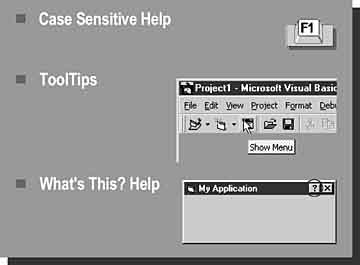Lesson 4: The Windows Help System
Designing a Help System
When designing a Help system, it is important to identify the users of your application. Your audience determines the type of information you make available in your Help system and how you present that information.Users of Help systems might be classified in the following ways.
| User | Background |
| Computer novice | Completely new to computing. |
| Application novice | Some knowledge of computing, but new to your kind of application. For example, if you are providing Help for a spreadsheet program, the application novice may be familiar only with word-processing packages. |
| Application intermediate | Knowledgeable about your kind of application. |
| Application expert | Extensive experience with your kind of application. |
Planning for Novice Users
Novice users need help learning tasks and getting acquainted with the interface. These users require topics that define new, application-specific terminology or that offer conceptual and task-oriented information.Planning for Intermediate and Advanced Users
Sophisticated users occasionally use Help for a procedure or term , but most often need to refresh their memory of statements and functions. The expert user tends either to look up reference information or to seek help only with statement or function syntax, keyboard equivalents, and shortcut keys. This is especially true for users of a language Help system.Planning for All Types of Users
If you are providing a Help system for all types of users, you should document menu commands, procedures, definitions of new terms, features, functions, and all other relevant aspects of an application.Consider carefully the decision to implement context-sensitive Help. Because context-sensitive Help demands a close working relationship between the Help writer and the application programmer, the development time required to create a successful context-sensitive Help system increases significantly.
Implementing Help in an Application
Help can be implemented in a number of ways. An application can use the Windows Help system, ToolTips, or the What's This? Help feature of certain controls. 
Help System
When using the Windows Help system, you can allow the user to invoke Help from a command, such as a Help command button or a Help menu. You can also provide context-sensitive Help. If the HelpContextID is set for the control, and a .HLP file is referenced for the project, when a user presses F1 the Windows Help system will automatically start, load the specified Help file, and move to the topic by ID.Microsoft Windows Architecture for Developers Training Kit
ISBN: B00007FY9D
EAN: N/A
EAN: N/A
Year: 1998
Pages: 324
Pages: 324
Authors: Microsoft Corporation
- ERP Systems Impact on Organizations
- ERP System Acquisition: A Process Model and Results From an Austrian Survey
- Enterprise Application Integration: New Solutions for a Solved Problem or a Challenging Research Field?
- Distributed Data Warehouse for Geo-spatial Services
- Relevance and Micro-Relevance for the Professional as Determinants of IT-Diffusion and IT-Use in Healthcare